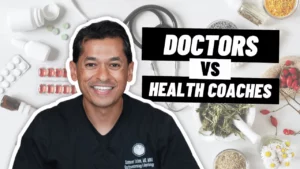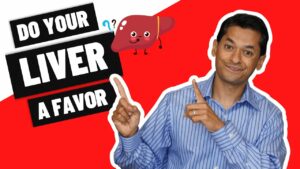This video discusses food allergies and the distinction between allergies and intolerances. It outlines the top nine allergens that must be listed if present on food labels, and it also explains the immune system reaction in regards to allergies. Additionally, it emphasizes the importance of observing one’s responses to certain foods and reading food labels to further identify food allergies or intolerances.
VIDEO HIGHLIGHTS
- Food allergies can be very serious and life-threatening conditions, with symptoms ranging from itching in the mouth to anaphylaxis.
- Food allergies may not always stay the same throughout a person’s lifetime – some individuals can outgrow their allergies or develop new ones as they age.
- Peanut allergy only accounts for 2-3% of food allergies, with other common allergens including milk, eggs, tree nuts soy wheat fish and shellfish.
- Even small amounts of allergen exposure can trigger a response in those with food allergy; it is important to take preventative measures such as informing restaurants about dietary restrictions and avoiding cross contamination when preparing meals at home.
- All nine most common food allergens must be listed on product labels by law but there are many more that do not have to appear on labels so caution should still be taken when consuming unfamiliar foods or ingredients if one has known allergic reactions/intolerances.
FULL TRANSCRIPT
Did you know this kid whenever you were younger? You know that kind of weird kid had the pocket protector to protect their pens. Had those really thick glasses, maybe that little tape in the middle. You know that kid that also carried around that pen? You know that EpiPen, he was allergic to bees, nuts, dirt, wind, pretty much everything.
Oh, got it. That kid was me. Yes, it was me as well. I know the nus. Cool swap character, right? Players food allergies in kids and adults are no joke. In today’s video, I’m gonna go through five myths about food allergies and the very end of the video I’ll explain the difference between a food allergy and a food intolerance.
Guys, let’s talk about poop. How do y’all, Dr. Islam here, AKA you are poop guru, trying to give you yes you the best tips and trick so you can live your best life from the top all the way down to your, you haven’t already. Don’t forget to subscribe to my channel so you can get great videos like you’re learning in today’s video.
Myth number one, food allergies are not that serious. Ah, this is completely false. In fact, food allergies can be a very serious and life-threatening condition. Now, symptoms can range from a little bit of itchiness in your mouth. Maybe you break out in a rash to life-threatening cardiac failure where your heart stops breathing and your body actually cannot allow it to breathe.
That is called anaphylaxis. And around 30,000 people every single year get hospitalized from serious food allergy infections from anaphylaxis. And this has led to a number of people passing away from this. If you have a food allergy, take it serious cuz it actually can lead to someone possibly dying. Number two, once allergic, always allergic. This is also a very common myth.
A lot of people think that when they had an allergy, when they were younger, they’re gonna continue to have the same allergy with the same response as they get older. And it’s actually surprising that a number of individuals can outgrow their allergies. Yes, no. Can you grow bigger and stronger? You can actually outgrow those allergies as well. So there are people who may have had nut allergies or egg allergies when they’re younger.
And through the consequence of time and exposure, they’re able to eat those foods again when they’re older. And in fact, did you know you can also develop new intolerances or allergies when you get older? Oh yeah. One more common ones is dairy or lactose intolerance. So for me, when I was younger, I loved milk, not an issue. Had that ice cream, ah, it was great. But as I got older, I noticed when I had ice cream and milk, ah, thank you. It was terrible. Almost as if a bomb went off in my stomach causing gas, bloating in diarrhea. And I came to realize that over time I developed a milk allergy. And there’s actually a very common reason why people have gut issues and they don’t realize it is that they’re lactose.
Myth number three, it’s all about the peanuts. You know all about the Benjamins Baby, all about the peanuts, baby. This is a very common myth. Now, peanuts tend to get a lot of information on the media because of how prevalent this is in terms of the allergy that people have and also the response to that and how often we happen to have peanuts.
But did you know peanut allergy only consists of about two to 3% of the total food allergies that are out there? That’s not that much. In fact, some of the more common food allergies outside of peanuts by far include things like milk, eggs, trees, nuts, soy, wheat, fish, and shellfish. So even though nuts can be troublesome, they’re not the most common food allergy that’s out there. Myth number four, eating a little bit not a big deal. Wrong, wrong, wrong, wrong, wrong. Even a small amount of food that you are exposed to can cause such a big response in your entire body where you can have difficulty breathing and your heart stops. Any exposure, no matter how small it is, can trigger a response To be completely safe, you need to remove all aspects of getting that allergen to you, including your kitchenware and the place where you typically cook. You have to separate these items so they don’t become cross-contaminated and have accidental issues whenever you’re eating and preparing those foods. And this is very important in a restaurant setting. This is why I tell my patients, let the restaurants know you have a serious food allergy. Because some people in some restaurants and some cooks may not realize that they can cross-contaminate foods and cause you to actually be exposed to that food allergy myth. Number five, all allergy ingredients must be on the food label. Unfortunately, this is a very common myth which can lead to threatening consequences. A federal law from 2006 states that the nine most common food allergies should be listed on your label.
That being said, those are not the only foods that can cause food allergies. Ellis can be hundreds and only the top nine have to be on that food label. So if you’re a person who’s prone to allergies, be very careful that you either speak to the manufacturer or go to the source of the people who are producing that food. So now that we talk about food allergies, let’s discuss what is the difference between a food allergy, any food intolerance. So if food allergies actually where your body attacks itself, you actually have an immune response once you have cells in your immune system attacking the body because of what it ingested. And you can have a variety of essentials, like I mentioned before, maybe some rash, some high, some itchy mouth.
It can be as severe as anaphylaxis. And there are ways to test for food allergies, whether you see an allergen or other tests that are out there. This is very different from a food intolerance in which the most common symptom is GI upset. And there are no specific tests that we can test for a food intolerance. In fact, food allergy testing is not recommended for those individuals who are looking for a food intolerance.
And the symptoms typically are in the GI tract, including bloating, pain, nausea, abdominal dissension, symptoms like that. Now the best test for food intolerance is Your response to those foods. So for example, if you’re like me, you had dairy and oh my gosh, you’re all bloated and big, that means that you most likely have a food intolerance to dairy.
So here is my call to action for you. I want you at home to start reading the labels, seeing how you respond to certain foods or ingredients. You may have a food allergy or a food intolerance, you may not even realize it. Look on there and see if anything is making you sick. Guys, and thank you for watching. Don’t forget to smash that light button live, share and subscribe. And don’t forget to subscribe to my channel when we get great tips and tricks like you’re learning in today’s video, guys, and thank you for watching. Don’t forget, let’s talk about poop. Thanks everyone.



